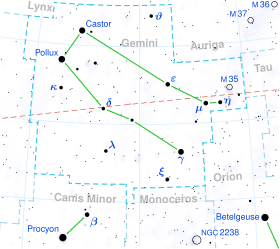Top Qs
Timeline
Chat
Perspective
81 Geminorum
Star in the constellation Gemini From Wikipedia, the free encyclopedia
Remove ads
81 Geminorum is a binary star[8] system in the northern constellation of Gemini. It has the Bayer designation g Geminorum, while 81 Geminorum is its Flamsteed designation. This system is visible to the naked eye as a faint, orange-hued point of light with an apparent visual magnitude of 4.89.[2] The pair are located approximately 360 light years away from the Sun, based on parallax,[1] and are moving further away with a radial velocity of +83 km/s, having come to within an estimated 164 light-years of the Earth nearly a million years ago.[2] 81 Geminorum lies close enough to the ecliptic to undergo lunar occultations.[4][9]
The variable velocity of this system was first suspected at the Dominion Astrophysical Observatory in 1921, then confirmed by the Lick Observatory in 1922. It is a single-lined spectroscopic binary with an orbital period of 4.2 years and an eccentricity of 0.325.[4] The visible component is an aging giant star with a stellar classification of K4 III,[3] having exhausted the supply of hydrogen at its core then expanded to 34[1] times the Sun's radius. It is over six[5] billion years old with 1.22[5] times the mass of the Sun. This is a candidate alpha-enhanced star that displays a significant overabundance of silicon.[10] The star is radiating around 287[1] times the Sun's luminosity from its bloated photosphere at an effective temperature of 4,095 K.[1]
Remove ads
References
Wikiwand - on
Seamless Wikipedia browsing. On steroids.
Remove ads

